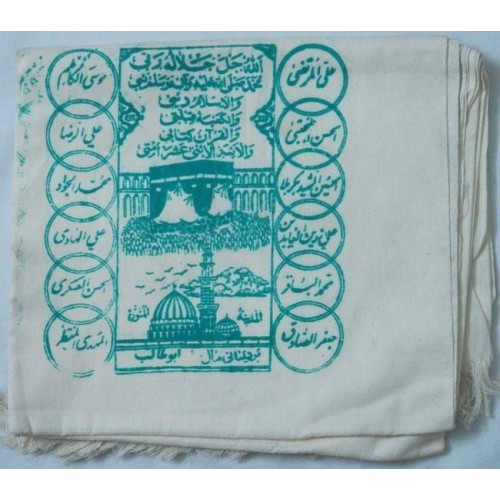- On sale!



Shia Islam Bord-e Yamani Kafan Coffin Burial Shroud With 12 Imams Names, A muslim essential beliefs & Kaaba & Masjid Al-Nabi printed on
---
The writings on the middle top means:
I testify that Allah is my Lord
Muhammad is my Prophet
Islam is my religion
Kaaba is my Qiblah
Quran is my Holy Book
the 12 Imams are my Imams
---
In the past Bord e Yamani, an expensive version of kafan made in Yemen was favored by the wealthy. However this item is hard to find now and most people use the regular cloth.
SEE BELOW FOR MORE INFORMATION.
Rituals of Death in Shia Islam
Funeral rites involved burial of the dead.
The body should be buried within 24 hours. It will be washed in line with Islamic traditions, scented with camphor ‘Kafoor’ (used by Zoroastrians as well) and wrapped in a white cloth (Kafan) with prayers recited. The person who performs the washing (Mordeh Shoor), should be a Muslim and from the same sex as the deceased. Sometimes close relatives or friends may undertake the washing themselves but this is not very common. In the past the dead could be washed at home, but most Iranians today go to the designated places and in major cities such acts are banned for heath concerns. If washed at home this took place outdoors in an enclosure set up for the occasion to protect the body from being seen. With the dead females the body was washed in an enclosure covered on every side including the top, so that the female’s naked body was not exposed to even sun or sky. The whole body will be washed including the hair. Nails will be cleaned and shortened. Once the body is washed ablutions are performed. Three watery solutions made with Sedr (an ancient cleansing substance) camphor (kafoor) and plain fresh water are used. The hands are washed first, then the genitals, the head, the right and the left side of the body and eventually the entire body is lightly rubbed with the solutions.
Three washes are performed with each solution and all together there are nine ablutions. For most Iranians today three washes one with each solution is the common practice. At the end all body openings such as ears, nostrils and even genital areas will be blocked with cotton balls. Specific prayers are said and at the end the body washer repeatedly asks Allah to forgive the dead for whatever sins the deceased might have committed. All clothing worn by the dead is normally donated to the body washer.
The rituals were a lot more detailed till 19th century but presently they are simplified. For example it was customary to place fresh sticks from a date tree or pomegranate under the arms of the deceased believing the dead could hold on to them for support once questioned by the two spirits Nakeer and Monker. Or if wealthy they would put a semi precious stone like agate with panj tan prayers carved on it under the deceased tongue. Muslims believe that the name of their saints will protect them. It is quite common to have five names (panj tan) or fourteen (14th innocents) or forty names (chehel tan) carved to be used for protection. In this case the panj tan enabled them to answer properly once questioned by the spirits. The five are the most venerated of all Shiite characters and include Prophet Muhammad, Ali, Hassan, Hossein and Fatima. With extremely pious Muslims always participating at Moharram gatherings for Imam Hossein, the handkerchief used to wipe their tears was tied around their forehead to indicate to the spirits that they have shed tears for Imam Hossein. With females a prayer bead from Kerbela were placed around her neck to show the spirits she has been a good Shiite and has mourned for Imam Hossein.
Once washed, dried and purified the body is placed on a large white cotton cloth called kafan. With the rich the material is imported from Kerbela. In the past Bord e Yamani, an expensive version of kafan made in Yemen was favored by the wealthy. However this item is hard to find now and most people use the regular cloth. Smaller pieces of the same material will be used to wrap around the lower legs, cover the eyes, the lower abdomen from belly button to knees, and to cover breasts if female. Then the whole body will be covered with kafan. Both ends will be tied with ropes before placing in the coffin. The kafan is never sewn and it is regarded a sin to tie the ends by sewing. After the deceased is washed and wrapped in the white cloth (kafan), either two or four males carry the dead. The body is taken to the coffin but will not be placed in it, instead it will be put down on the ground. They repeat the act three times before eventually placing the body in the coffin at the fourth attempt. The gesture symbolizes the deceased refusal to leave his earthly life behind. Verses from Quran are recited at all times and every few minutes everyone shouts ‘there is no god but Allah’ (La elaha ela lah). It is regarded a blessing to touch the coffin and help carrying it. So it is quite expected for total strangers to participate and carry the coffin for a short while.